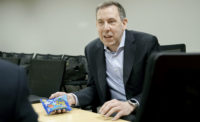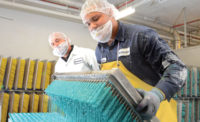It all began with the Ring Pop, that jewel-shaped piece of candy placed on a plastic ring that resembles a pacifier. In fact, Frank Richards, the Topps engineer who invented it in 1979, did so as a way of helping kick his daughter’s thumb-sucking habit.
Since then, Ring Pop has become one of America’s iconic brands, evolving from an ingenuous and convenient way to slurp on a sweet to what Bazooka Candy Brands, the Topps subsidiary that produces the bejeweled bling, calls “edible entertainment.”
At-a-Glance: Bazooka Candy Brands, div. of Topps Co., Inc.
Headquarters: New York City
Sales: $210 million
Plants: 2 - Scranton, Pa. and Buenos Aires, Argentina
Employees: 275
Management Team: Tony Jacobs, president; Anthony Trani, v.p. – global marketing and innovation; Melissa Corliss, v.p. – global operations; Christopher Lomino, v.p. – sales and customer marketing
Brands: Ring Pop, Baby Bottle Pop, Juicy Drop, Bazooka Bubble Gum, Push Pop, Match-Ems
Products: Lollipop novelties, gummies, bubble gum
That term, which is what drives Bazooka Candy Brands (BCB) today, encompasses an unprecedented amount of innovative effort; heavily researched consumer insights and feedback; highly coordinated global supply chain logistics; and ongoing retailer engagement.
It’s also a strategy that has propelled the company to be one of the leading front-end non-chocolate suppliers in the United States, consistently outperforming candy category growth for the past five years. Last year, the company posted $210 million in sales, 30 percent coming from exports. Domestic revenues grew 10.4 percent over 2016, while exports rose 12 percent.
Tony Jacobs, president of BCB rattles off the company’s reasons for success like popping powder exploding in one’s mouth: Juicy Drop, Baby Bottle Pop, Push Pop, Ring Pop Gummies, Bazooka and the recently launched Match-Ems.
“For example, Juicy Drop is the No. 1 brand in our portfolio today,” he says. “And with the launch of Juicy Drop Gum last year, it has spurred that brand’s growth significantly.”
Upon examining the product, it’s hard not to see why it’s captured the hearts, minds and tastes of youngsters. Imagine a piece of gum shaped like a U channel that enables one to squirt a sour gel into a “drop zone.”

The concept allows kids to fill the drop zone with sour gel, pop the gum into their mouth and then squirt more gel into their mouth to zap additional flavor during the chewing process. Cool or what?
As Jacobs emphasizes, “We’re all about fun, silliness and entertainment. But we do take everything we produce incredibly seriously.”
Melissa Corliss, v.p. of global operations, echoes that sentiment. As she explains, it took between 12 and 18 months to perfect the product, from original concept to a deliverable.
“We work very closely as a team [executive, sales, marketing, innovation and operations], Corliss says. “There are some amazing and very different ideas thrown out there. But nobody ever says it can’t be done.”
As she explains, it was critical to get the gum just right.
“Developing the drop zone wasn’t easy; no one has a gum with a drop zone,” Corliss points out. “Then you have to package it for the kids, make it look cool and ensure that it performs. In the end, it was the perfect mix of sweet and sour.”

But how did retailers react to the innovation? Juicy Drop Gum took top honors at Candy Industry’s/ECRM Buyer’s Choice Award for Best New Novelty Product in 2016. Coincidentally, the package is patent-pending.
The Juicy Drop Gum success story actually reveals BCB’s ongoing business strategy of leveraging its power brands with breakthrough innovation. After all, the Juicy Drop Pop itself was an innovative and interactive twist on lollipops and flavor fusion, allowing children to add drops onto their lollipops or their tongues.
Now come more examples:
In 2017 the company introduced a “more active” version of Baby Bottle Pop, which came out in 1998, with its Popping Powder cousin. Children can now dip their Baby Bottle Pop into flavored popping powder for an “explosive” taste sensation. And by the way, it won Candy Industry/ECRM’s Buyers Choice Award for Best Novelty Candy last year, as well as Candy Industry/ECRM’s 2018 Kids Choice Award.
The company also introduced Bazooka Sugar-Free Gum, which won the NCA’s Most Innovative New Product Award for gum in 2016. This sugarless version mimics the original Bazooka bubble gum in taste, but not in shape – it’s in tablet form as opposed to the original dusted sugar stick format – or packaging – in a 60-piece to-go cup format as well as 22-piece plastic tubes. Moreover, it’s also certified by the American Dental Association.

Then there’s the Ring Pop brand extension into gummies, first with Ring Pop Gummies – they actually are shaped like Ring Pops, followed by Ring Pop Gummies Chains, which feature a variety of emoji-inspired charms connected onto an edible chain.
And this year, the company launched Match-Ems, a totally new twist on gummy innovation. The product features interlocking gummy pieces that not only deliver play value, but also provide 28 flavor combinations from eight base flavors.
Two years in development, the recently launched gummy product features the latest 3-D technology while maxing out the fun factor through DIY flavor fusion. For example, piece together banana and orange, and you get bubble gum flavor; sour green apple and pear, kiwi.
“Kids continuously want more flavors as well as customization,” says Corliss.
“There’s no gummy out there like this,” adds Christopher Lomino, v.p – sales and customer marketing. “It’s not a me-too item, but one that makes a point of difference. And we expect it to outperform the category.”
Of course, there’s more in the pipeline. So where do all the creative ideas come from? As Anthony Trani, v.p. global marketing and innovation, explains, “We leave no stone unturned. We look for the greatest ideas everywhere, be it external sources, inventors, manufacturing partners.”
In the end, it comes back to the team, he explains. Upon finding the ideas, and then getting them produced, the item undergoes a rigorous consumer testing process, which encompasses qualitative and quantitative research.
“We also conduct a large online survey that gives us greater focus,” Trani says.
The aim is to turn our brands into platforms, he explains. Trani cites Juicy Drop as an example, whereby the brand was extended into taffy, then gummies, and finally gum.

“We did that with Baby Bottle Pop with the popping powder as well,” he points out. “Of course, there are more ideas on the horizon.”
Some of those ideas involve licensing. After all, parent company Topps’ legacy was built on licensing contracts with Major League Baseball, the National Football League, the National Basketball Association and the National Hockey League.
The acquisition of Topps by former Disney CEO Michael Eisner and his Tornante Co. in conjunction with Madison Dearborn Partners in 2007 guaranteed an expanded connection to licensing through the entertainment media.
“Strategic licensing is an important part of our plan,” Trani says. Just recently BCB teamed up with Galerie in offering a surprise egg containing a chocolate candy egg and a surprise collectible, a Peppa Pig figurine. New launches include My Little Pony and a non-chocolate Spiderman surprise item, as well as a non-licensed item that features “Everyday Heroes,” such as doctors, firefighters, policemen.
As Lomino points out, “The milk chocolate toy surprise segment is exploding. Our partnering agreement with Galerie isn’t just about distribution, it’s about brand building. That’s what we do.”

That brand building expertise is now extending into the back of the store, he says. Thus, consumers can find Juicy Drop Gummies, Juicy Push Pops and Ring Pop in standup pouches in the candy aisle. Match-Ems, which was just launched, will be available at the front end as well as the back of the store.
Thanks to the brands’ performance at the front end — “Our brands outperform Skittles and Starburst with certain retailers,” Lomino says — BCB brands are garnering additional distribution. The numbers provide the company with a strong case for shelf space.
“Fact-based selling is critical for any consumer packaged goods company today,” he says. “It’s not just about the category, but adjacent categories.”
And while Lomino acknowledges that BCB doesn’t play the role of category captain, that title going to the multinationals, he says, “We’re the category validator.
“Our size makes us more flexible, more nimble, which we use to our advantage.”

And that now applies to seasonal, an area that receiving more attention from BCB. Last year the company came out with Juicy Drop candy canes that were sold at Walmart. The “lick and dip” — yes, you lick the canes and dip it into a vial containing sour gel — did “very well” and will be launched nationally this year.
Baby Bottle Pop candy canes, featuring the famous powder as the interactive, flavor-enhancing element, will accompany its Juicy Drop cousins as a seasonal offering this year. The company is also offering consumers a “big bag” item for Halloween, featuring a mix of BCB’s brands.
Given the innovative concepts, and the depth and breadth of branded products, it’s not surprising to see that BCB continues to expand its exports.
“International has become a huge focus for us,” Jacobs says. “We’re in every country in Latin America, in Western Europe, Asia, South Korea, Japan and the Middle East. We posted double-digit gains in the Middle East last year. We’re the No. 1 non-chocolate candy manufacturer in Saudi Arabia and No. 3 in the United Arab Emirates in modern accounts.”
But it’s not just sales that are international; so is manufacturing. In addition to the 34,000-sq.-ft. plant in Scranton, the company recently set up production in Buenos Aires, Argentina, in its own facility, which facilitates sales through South and Latin America.
It also works with seven co-manufacturers in North America, Europe and Asia, Corliss says. “One of them has been with us 30 years,” she adds. “We work with suppliers that have the same values as we do, which encompasses sustainability. And we also perform a social audit to ensure fair treatment of employees as well as environmental compliance.”

In Scranton, the company runs 24/5 and only produces Ring Pop, about a million each day. About 19,000 sq. ft. of the facility is dedicated to two production lines, each one capable of turning out 10- and 14-gram Ring Pop lollipops.
That capability came about in 2015, thanks to investing in new aluminum alloy moulds, says Tom Shermanski, Scranton’s plant manager. That coincided with testing new Teflon coatings on the moulds in order to produce a sour Ring Pop.
“With the original coatings, we were unable to produce a sour Ring Pop,” he explains. “However, throughout the years, Teflon coatings evolved, so we decided to take advantage of the new coatings.”
It took eight months of testing and 30,000 revolutions [a single deposit cycle] before Shermanski found the right coating. Since its implementation in 2015, the new coated moulds have performed flawlessly in producing sour Ring Pop lollipops.
Shermanski also points out that the actual rings used for holding the hexagonal-shaped pops are actually produced locally in Pennsylvania. The 2.7-gram rings consist of a disk, hook and stem. The stem has a ribbed contour to keep the lollipop in place, which is key to making it possible to enjoy the product while it’s on a finger, he adds.

Of course, as an iconic brand, Ring Pop has a place among generations. Jacobs cites the fascination that adults who have grown up with it have for the product, citing engagements, wedding parties and the like. (See sidebar).
It’s all about leveraging that brand, and others in the portfolio to keep BCB growing.
Citing rapper DJ Khaled’s inspirational video, “Another One,” Jacobs says it’s all about delivering another one in terms of innovation, distribution and merchandising. With his team, BCB’s president is confident the group will deliver “another one” yet again.
An engaging proposal
Taylor Kinney did it. So did Nick Cannon. And so have countless non-celebrities. Propose, that is, with a Ring Pop. Yes, the lollipop on a ring.
Hard to believe, I realize, but it’s all there if you’re a celebrity watcher. Taylor Kinney did so to Lady Gaga on Dec. 7, 2014. Yes, he did follow through with a real heart-shaped diamond ring, but as AccessOnline reports, Lady Gaga said that she was happy with the candy.

As for Nick Cannon, both he and Mariah Carey loved Ring Pop. Thus, when he proposed, he slipped a real diamond ring inside a Ring Pop wrapper. Stealth, I tell you. On their second anniversary, Cannon reinforced that love — for each other and Ring Pop — with a 35-carat diamond ring shaped like a Ring Pop. Sweet bling!
But it’s not just a Hollywood thing. Anyone looking to insert some spontaneity, romance, whimsy and some syrupy (literally) sentimentality in this most traditional of life events often turn to Ring Pop. A quick scan of the Internet clearly shows how popular this concept is.
There’s even the case of a couple who had their wedding rings stolen off a Federal Express truck, only to save the day by opting for Ring Pop during the ceremony.
What’s behind this fascination with faux yet tasty jewelry? Perhaps it’s recognition that such a serious public commitment needs a bit of levity, a human moment of sure and sugary joy. In the end, there’s nothing wrong with saying I do to a sweet life.




















